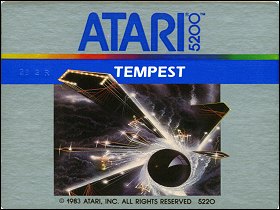 The Game: As a strangely crablike creature, you scuttle along the rim of an abstract, hollow geometric tube, zapping red bow-tie-ish critters and purple diamond-shaped things which carry them. There are also swirly green things which spin “spikes” like webs, and by the way, you should avoid spikes. (Atari, 1983)
The Game: As a strangely crablike creature, you scuttle along the rim of an abstract, hollow geometric tube, zapping red bow-tie-ish critters and purple diamond-shaped things which carry them. There are also swirly green things which spin “spikes” like webs, and by the way, you should avoid spikes. (Atari, 1983)
Memories: The above description barely fits this game because it only exists in an unfinished form, with just a few bare essential elements of the game in place. You can shoot stuff and score points, but there isn’t much “game” there – the collision routines don’t exist that would determine whether or not your on-screen flipper “dies” by touching an approaching enemy, or an enemy’s incoming fire for that matter.
 If you can set the unfinished nature of the game aside for a moment, however, it’s easy to imagine that Tempest – still a popular arcade quarter-grabber in 1982/83 and well on its way to the “timeless classic” status it enjoys now – could’ve been a killer app for the Atari 5200. We’ve already reviewed an unreleased prototype programmed for the less powerful Atari 2600, which was a nearly-incomprehensible mess of a game, but the difference between that prototype and this one is simply monumental. This Tempest truly feels like its arcade counterpart in this version, and looks and sounds like it too, making some obvious allowances for the rough nature of any vector graphics game translated for a home console.
If you can set the unfinished nature of the game aside for a moment, however, it’s easy to imagine that Tempest – still a popular arcade quarter-grabber in 1982/83 and well on its way to the “timeless classic” status it enjoys now – could’ve been a killer app for the Atari 5200. We’ve already reviewed an unreleased prototype programmed for the less powerful Atari 2600, which was a nearly-incomprehensible mess of a game, but the difference between that prototype and this one is simply monumental. This Tempest truly feels like its arcade counterpart in this version, and looks and sounds like it too, making some obvious allowances for the rough nature of any vector graphics game translated for a home console.
 Had Tempest made it to the store shelves back in the day (instead, it was shelved in a different way when the bottom fell out of the video game boom and Atari put its games-in-progress in a deep freeze), it probably would have received rapturous reviews and become a truly unique version of a truly unique game, available only on the next-generation platform that Atari was desperately trying to turn into its flagship product. (Of course, had the 2600 version gone to market in its sorry shape, there’s just as good a chance that it would’ve been treated much like 2600 Pac-Man was by critics and
Had Tempest made it to the store shelves back in the day (instead, it was shelved in a different way when the bottom fell out of the video game boom and Atari put its games-in-progress in a deep freeze), it probably would have received rapturous reviews and become a truly unique version of a truly unique game, available only on the next-generation platform that Atari was desperately trying to turn into its flagship product. (Of course, had the 2600 version gone to market in its sorry shape, there’s just as good a chance that it would’ve been treated much like 2600 Pac-Man was by critics and  consumers alike, and would’ve damaged the 5200 version’s chance of making a dent.)
consumers alike, and would’ve damaged the 5200 version’s chance of making a dent.)
We’ll never know for certain how the market would’ve responded to 5200 Tempest, but one thing is clear: it could have made gamers and Tempest fans alike very happy.

